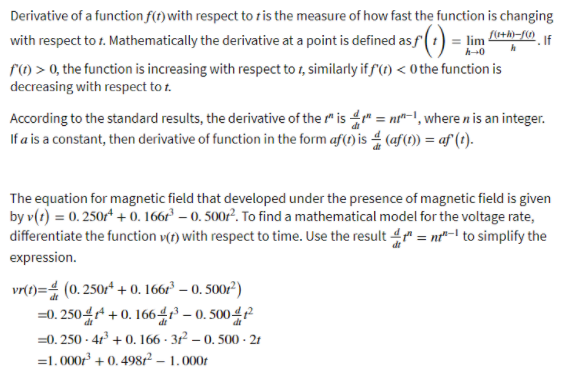5. Manually use Bisection iterative technique with 6 iterations to find a root of vr(t) in the intervals [0.3 :0.7] and [-1: -5]. Calculate the percentage of error. Show details of your steps.
Family of Curves
A family of curves is a group of curves that are each described by a parametrization in which one or more variables are parameters. In general, the parameters have more complexity on the assembly of the curve than an ordinary linear transformation. These families appear commonly in the solution of differential equations. When a constant of integration is added, it is normally modified algebraically until it no longer replicates a plain linear transformation. The order of a differential equation depends on how many uncertain variables appear in the corresponding curve. The order of the differential equation acquired is two if two unknown variables exist in an equation belonging to this family.
XZ Plane
In order to understand XZ plane, it's helpful to understand two-dimensional and three-dimensional spaces. To plot a point on a plane, two numbers are needed, and these two numbers in the plane can be represented as an ordered pair (a,b) where a and b are real numbers and a is the horizontal coordinate and b is the vertical coordinate. This type of plane is called two-dimensional and it contains two perpendicular axes, the horizontal axis, and the vertical axis.
Euclidean Geometry
Geometry is the branch of mathematics that deals with flat surfaces like lines, angles, points, two-dimensional figures, etc. In Euclidean geometry, one studies the geometrical shapes that rely on different theorems and axioms. This (pure mathematics) geometry was introduced by the Greek mathematician Euclid, and that is why it is called Euclidean geometry. Euclid explained this in his book named 'elements'. Euclid's method in Euclidean geometry involves handling a small group of innately captivate axioms and incorporating many of these other propositions. The elements written by Euclid are the fundamentals for the study of geometry from a modern mathematical perspective. Elements comprise Euclidean theories, postulates, axioms, construction, and mathematical proofs of propositions.
Lines and Angles
In a two-dimensional plane, a line is simply a figure that joins two points. Usually, lines are used for presenting objects that are straight in shape and have minimal depth or width.
Answer this question. Part (5).
![Analysis 2: The voltage potential, v(t), builds up on the loops, based on the orientation of the magnetic
field during an MR scan is given by:
v(t) = 0.250t+ + 0.166t³ – 0.500
and the voltage at time t= 0 is 0.
1. Formulate the mathematical model for the voltage rate vr(t) developed at the loops during
scanning.
2. Plot/Sketch vr(t) as a function of time t E [-4 : 4].
3. Find the roots of vr(t) analytically.
4. Use your figure to study the sign of vr(t) in the time interval [-4 : 4]. Does vr(t) have any root in the
interval [-4 : 4]? If yes, estimate the roots graphically.
5. Manually use Bisection iterative technique with 6 iterations to find a root of vr(t) in the intervals
[0.3 : 0.7] and [-1 :-5]. Calculate the percentage of error. Show details of your steps.
6. Manually use Newton-Raphson iterative technique with 6 iterations to find a root of vr(t) in the
intervals [0.3 : 0.7] and [-1 : -5]. Calculate the percentage of error. Show details of your steps.](/v2/_next/image?url=https%3A%2F%2Fcontent.bartleby.com%2Fqna-images%2Fquestion%2F482c6e1d-7657-4ad4-a4ba-74fc9a523b59%2Fede6ed7e-224c-4d1f-b745-3d1ff1fe7745%2F6m50lfr_processed.png&w=3840&q=75)

Step by step
Solved in 4 steps









